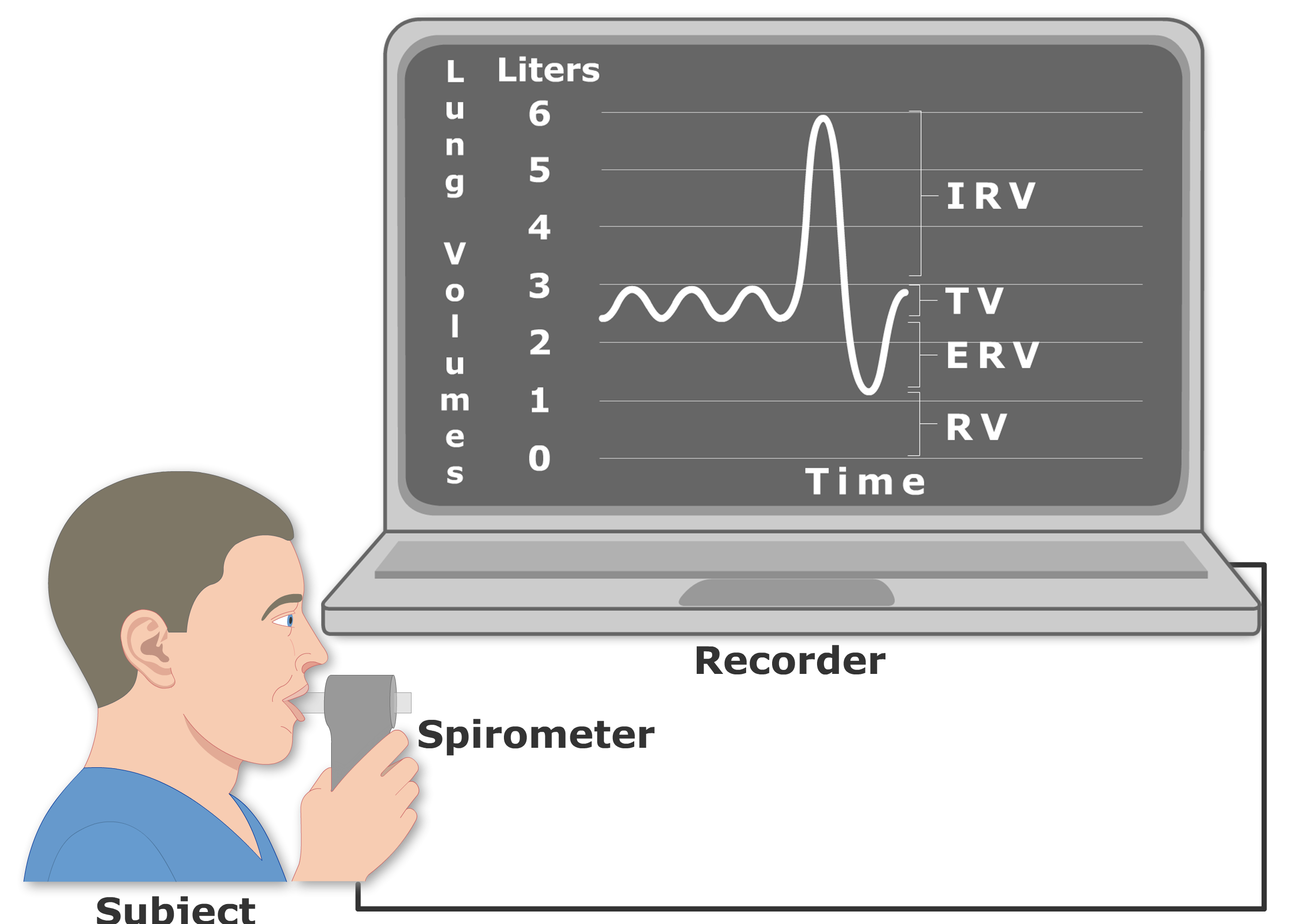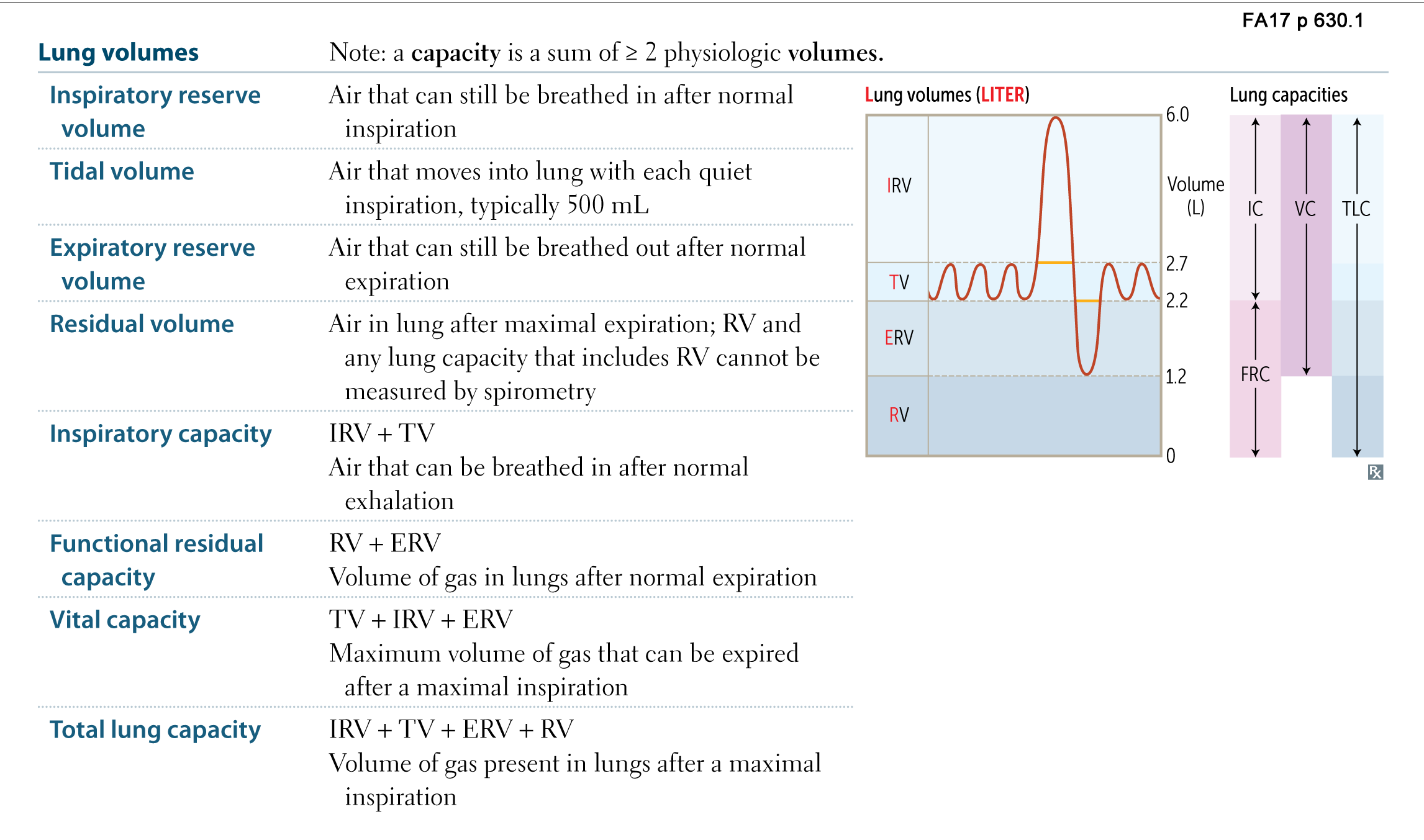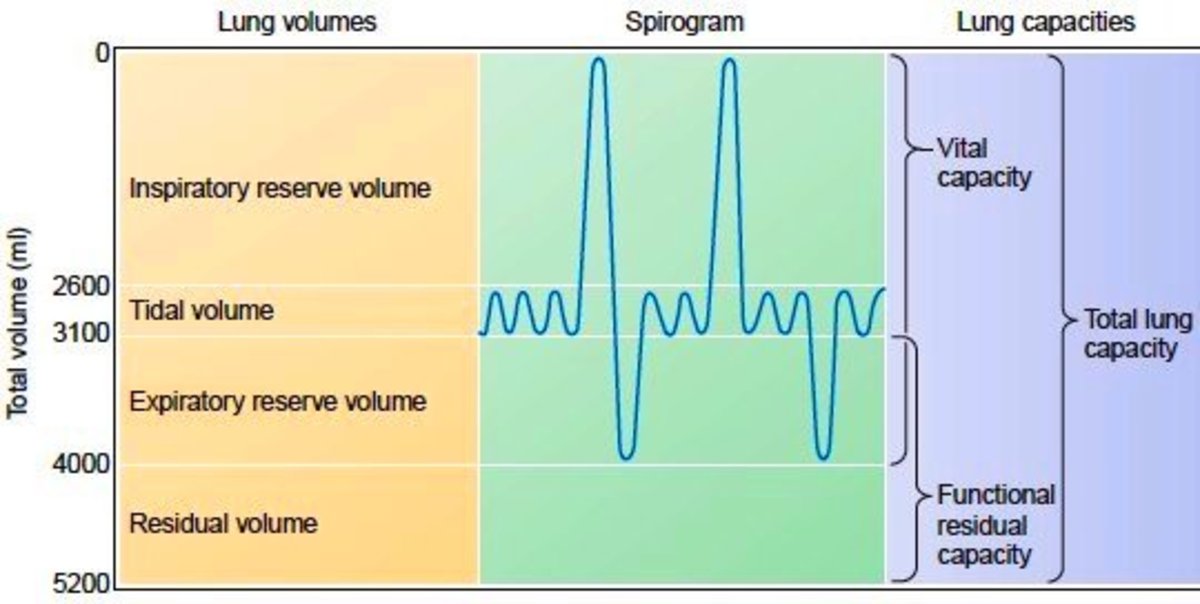Age gender body composition and ethnicity are factors affecting the different ranges of lung capacity among individuals. Inspiratory capacity is the amount of air taken in during a deep breath while residual volume is the amount of air left in the lungs after forceful respiration.

Total Lung Capacity An Overview Sciencedirect Topics

Lung Volumes And Capacities

Respiratory Physiology Lung Volumes Flashcards Memorang
It is about 80 percent of total capacity or 48 liters because some air remains in your lungs after you exhale.

Total lung capacity. The tidal volume is the volume of air that is inhaled or exhaled in only a single such breath. If your lung volume results fall outside of this normal range this may suggest you have an obstructive or restrictive lung condition. It is used to.
Forced expiratory volume is the most important measurement of lung function. Forced expiratory volume and forced vital capacity are lung function tests that are measured during spirometry. Human lung volumes and capacities.
Rigid bronchoscopy is often more effective than flexible bronchoscopy but it requires general total anesthesia. The maximum amount of air you can forcibly exhale from your lungs after fully inhaling. Laughing is a great exercise to work the abdominal muscles and increase lung capacity Singh says.
The total lung capacity of the adult male is six liters. Inspiratory capacity is the amount of air taken in during a deep breath and residual volume is the amount of air left in the lungs after forceful respiration. Your predicted total lung capacity TLC is based on your age height sex and ethnicity so results will differ from person to person.
Forced vital capacity FVC is the total amount of air exhaled during the FEV test. It also cannot be measured directly using spirometry and has to be calculated. The normal value is about 6000mL46 L.
This is called the total iron binding capacity TIBC. Forced vital capacity can decrease by about 02 liters per decade even for healthy people who have never smoked. Lung Capacity is increased by swimming underwater for extended periods and an oxygen bar will show up when you dive underwater showing the amount of.
The total lung capacity applies to the total volume of air-filled in the lungs after a forced inspiration. The primary end point was the annual rate of decline in forced vital capacity FVC assessed over a 52-week period. Over time our lung capacity and lung function typically decrease slowly as we age after our mid-20s.
Lung plethysmography one of several pulmonary function tests is used to determine TLC and this assessment of lung function can assist in diagnosing and evaluating different types of lung conditions. It is used to. Forced vital capacity FVC is the total amount of air exhaled during the FEV test.
A persons vital capacity can be measured by a wet or regular spirometerIn combination with other physiological measurements the. The total lung capacity of the adult male is six liters. Patients with more severe symptoms may have a reduced diffusing capacity of the lung for carbon monoxide.
Tidal breathing is normal resting breathing. An important part of a PFT involves measuring total lung capacity the gold standard for diagnosing restrictive lung disease. TLC TV ERV IRV RV.
TLC rapid increases from birth to adolescence and plateaus at around 25 years old. Diffusing capacity can also be important prior to lung surgery as a predictor of how well the surgery will be tolerated. Restrictive lung diseases are a heterogeneous group of conditions characterized by a restrictive pattern on spirometry and confirmed by a reduction in total lung volume.
It also clears out your lungs by forcing enough stale air out that allows fresh air to enter into more areas of the lung 7. It is a critical part of hemoglobin the protein in RBCs that binds oxygen in the lungs and releases oxygen as blood circulates to other parts of the body. Forced expiratory volume and forced vital capacity are lung function tests that are measured during spirometry.
Lung volumes and lung capacities refer to the volume of air in the lungs at different phases of the respiratory cycle. The FRC is a lung capacity consisting of the sum of two or more volumes. Total Lung CapacityTLC It is the maximum volume of air the lungs can accommodate or sum of all volume compartments or volume of air in lungs after maximum inspiration.
The average human respiratory rate is 3060. The lung capacity of a healthy man is estimated to be 6000 ml. Tidal volume is the volume of air inhaled in a single normal breath.
Vital capacity VC is the maximum amount of air a person can expel from the lungs after a maximum inhalationIt is equal to the sum of inspiratory reserve volume tidal volume and expiratory reserve volumeIt is approximately equal to Forced Vital Capacity FVC. Georges Respiratory Questionnaire SGRQ at week 52. A type 1 excludes note indicates that the code excluded should never be used at the same time as I270A type 1 excludes note is for used for when two conditions cannot occur together such as a congenital form versus an acquired form of the same condition.
It means not coded here. Diffusing capacity is a measure of how well oxygen and carbon dioxide are transferred diffused between the lungs and the blood and can be a useful test in the diagnosis and to monitor treatment of lung diseases. TLC is calculated by summation of the four primary lung volumes TV IRV ERV RV.
Iron is an essential nutrient that among other functions is necessary for the production of healthy red blood cells RBCs. The volume of collagen fibers in the airways was also quantified. Tidal volume is the volume of air inhaled in a single normal breath.
In the lung parenchyma the volume proportion of collagen fibers was measured by dividing the number of points hitting these fibers by the total number of points in the alveolar septa 1000 magnification 20 random fields per animal. A type 1 excludes note is a pure excludes. You may also have spirometry done if you are being treated for a chronic lung disease such as COPD asthma or pulmonary fibrosis to determine if your disease is improving or worsening and whether your medications or inhalers are working properly.
FRC is the total amount of air in a persons lungs at the lowest point of their tidal volume TV where the tidal volume is the volume of air a person normally inspires and expires. Lung capacity the ability to exhale forcefully. Forced expiratory volume is the most important measurement of lung function.
It is measured by assessing the total amount of air in the lungs after taking the deepest breath possible. Key secondary end points were absolute changes from baseline in the modified Rodnan skin score and in the total score on the St. This is the total volume of air that the lungs take in on maximum.
Lung capacity or total lung capacity TLC is the volume of air in the lungs upon the maximum effort of inspiration. Among healthy adults the average lung capacity is about 6 liters. Etiologies can be intrin.
This can help diagnose problems like asthma and COPD or can be done to check lung function before a surgery. Total lung capacity TLC is the maximum volume of air the lungs can hold. The average total lung capacity of an adult human male is about 6 litres of air.
Your lung capacity is the total amount of air that your lungs can hold. Normal results typically range between 80 and 120 of the prediction.

Lung Volumes And Capacities Owlcation
1
Total Lung Capacity

Spirometry Frcem Primary 5 Minutes At A Time Bromley Emergency
Why Does The Lung S Vital Capacity Decrease As We Age Quora

Static Absolute Lung Volumes Interpretation Of Pulmonary Function Tests A Practical Guide 3 Ed

Ratio Of Residual Volume Rv To Total Lung Capacity Tlc Plotted As Download Scientific Diagram

Vital Capacity Wikipedia
- Diet Metabolisme 13 Hari
- Samsung Imei Warranty Check
- 西藏 人缘 王
- Zodiak Bulan April
- Western Food Malaysia
- Setia Indah 11
- Axia Sport Rim
- Bat Share Price Malaysia
- undefined
- 敲 击 乐器
- Kapal One Piece
- La Tahzan Innallaha Ma Ana
- Best Lamb Chop In Kl
- Kisah Kisah Dalam Al Quran
- Shilpa Shetty Age
- Family Mart Nilai
- Klinik Azhar Dan Rakan Rakan
- Simpulan Bahasa Tangan
- Tukar Duit Raya Cimb 2021
- Senheng Bandar Puteri
